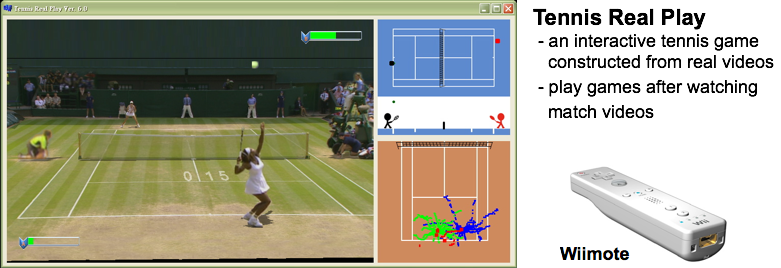Tennis Real Play
An interactive tennis game system constructed with models extracted from videos of real matches

Abstract
Tennis Real Play (TRP) is an interactive tennis game system constructed with models extracted from videos of real matches. The key techniques proposed for TRP include player modeling and video-based player/court rendering. For player model creation, we propose a database normalization process and a behavioral transition model of tennis players, which might be a good alternative for motion capture in the conventional video games. For player/court rendering, we propose a framework for rendering vivid game characters and providing the real-time ability. We can say that image-based rendering leads to a more interactive and realistic rendering. Experiments show that video games with vivid viewing effects and characteristic players can be generated from match videos without much user intervention. Because the player model can adequately record the ability and condition of a player in the real world, it can then be used to roughly predict the results of real tennis matches in the next days. The results of a user study reveal that subjects like the increased interaction, immersive experience, and enjoyment from playing TRP.
Paper Download
Jui-Hsin Lai , Chieh-Li Chen, Chieh-Chi Kao, Po-Chen Wu, Min-Chun Hu, and Shao-Yi Chien, “ Tennis Real Play ”, IEEE Transaction on Multimedia, volume 14, issue 6, 2012, Page 1602-1617.
Jui-Hsin Lai , Chieh-Li Chen, Po-Chen Wu, Chieh-Chi Kao, and Shao-Yi Chien, “ Tennis Real Play: an Interactive Tennis Game with Models from Real Videos ”, in Proceedings of the 19th International Conference on Multimedia, MM 2011, pp.483-492. (Full Paper 10 Pages)
News & Magazine
Report by NewScientist , Oct, 2011.
Patents
Method for decomposition and rendering of video content and user interface for operating the method thereof
Abstract
A method for decomposition and rendering of video content and user interface for operating the method thereof is disclosed. First, a plurality of target shots are recognized from a video, the video is decomposed into a plurality of video units based on the playtime of each target shot. Then, the video frame of target shot is decomposed into a background scene and at least one foreground object. The editing process is performed on the background to generate the plentiful visual effect. The video content of each video unit is known by analyzing the information of the foreground object, and therefore each video unit can be annotated. Furthermore, the user interface reintegrates the foreground object in the background scene and generates the customized video content according to users' request, so that viewers may get more enjoyment on game watching.
Abstract
本發明有關於一種影片內容分解與生成方法及其操作之使用者介面,首先,在一影片中識別出複數個目標鏡頭,並以各目標鏡頭的播放時間為基準點將影片分割成複數個影片單元,接著,目標鏡頭之影片畫面中分解出一背景場景及至少一前景物件,在背景場景上進行編輯以產生豐富的視覺效果,而藉由分析前景物件的資訊,以了解各影片單元的影片內容,並對於各影片內容進行註解,而後,使用者介面任意重組前景物件於背景場景上,以產生客製化的影片內容,致使影片的觀賞者可得到更多的觀看樂趣。
Method for Interacting with A Video and Game Simulation System
Abstract
A method for interacting with a video by a motion detector is disclosed. First, a video-content-decomposition procedure is executed to decompose the video into a background scene and at least one foreground object. Then, at least one event database is classified according to the state of the foreground object. Finally, the suitable foreground objects are selected from the event database according to a detected motion by the motion detector. Wherein, the foreground objects selected are rendered on the background scene sequentially according to the detected motion.
Presentation Slide
Demo Videos
Technique introduction with English subtitle and live demos.
If you cannot see the video below, click the link https://www.youtube.com/embed/FMczrfXyaYg
Technique introduction with Chinese subtitle and live demos. (影片解說 -- 中文字幕)
If you cannot see the video below, click the link https://www.youtube.com/embed/5qgDwMZYedM